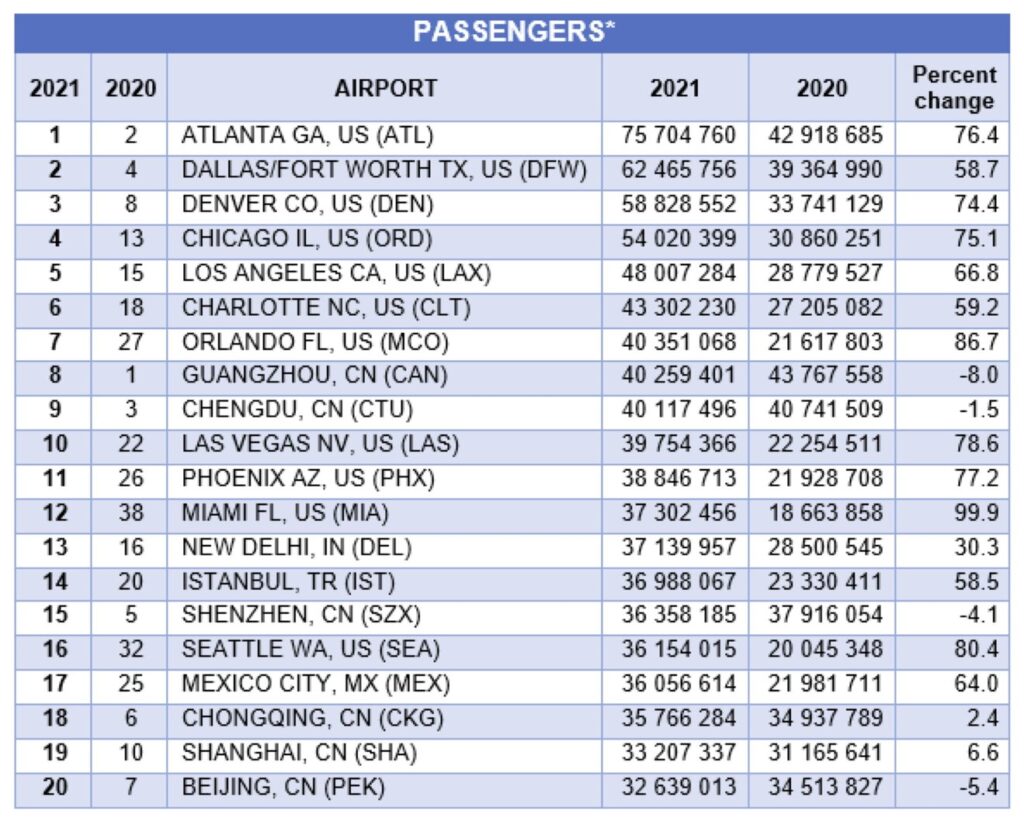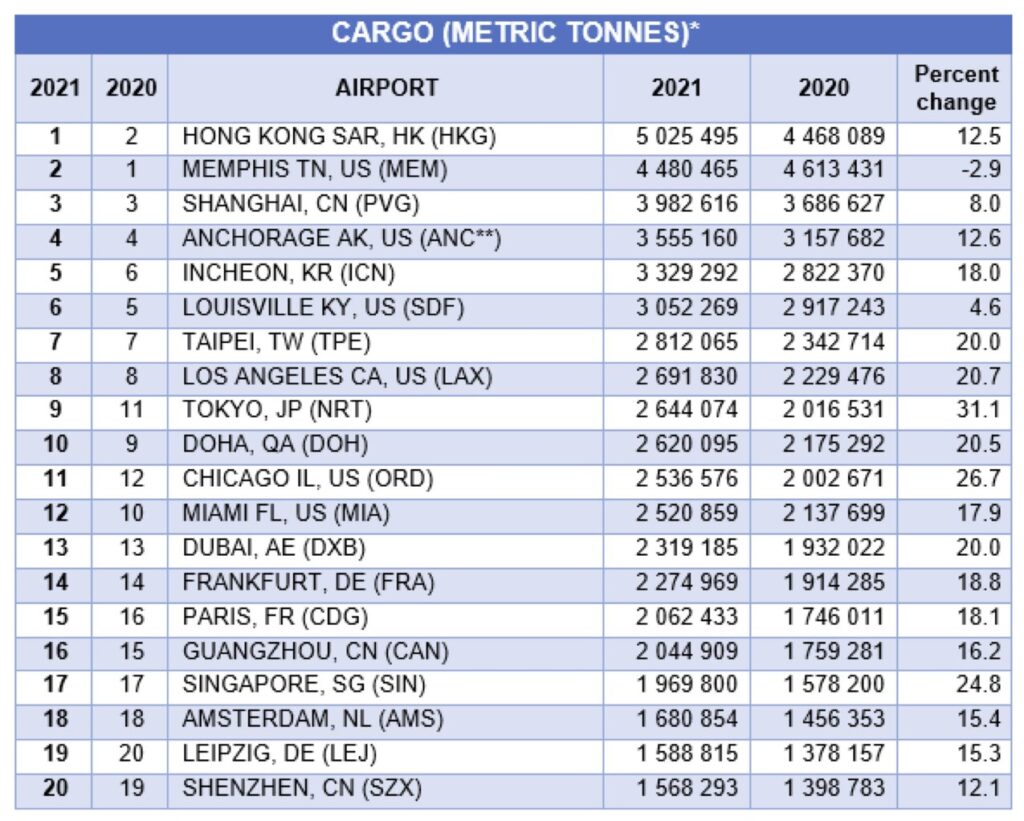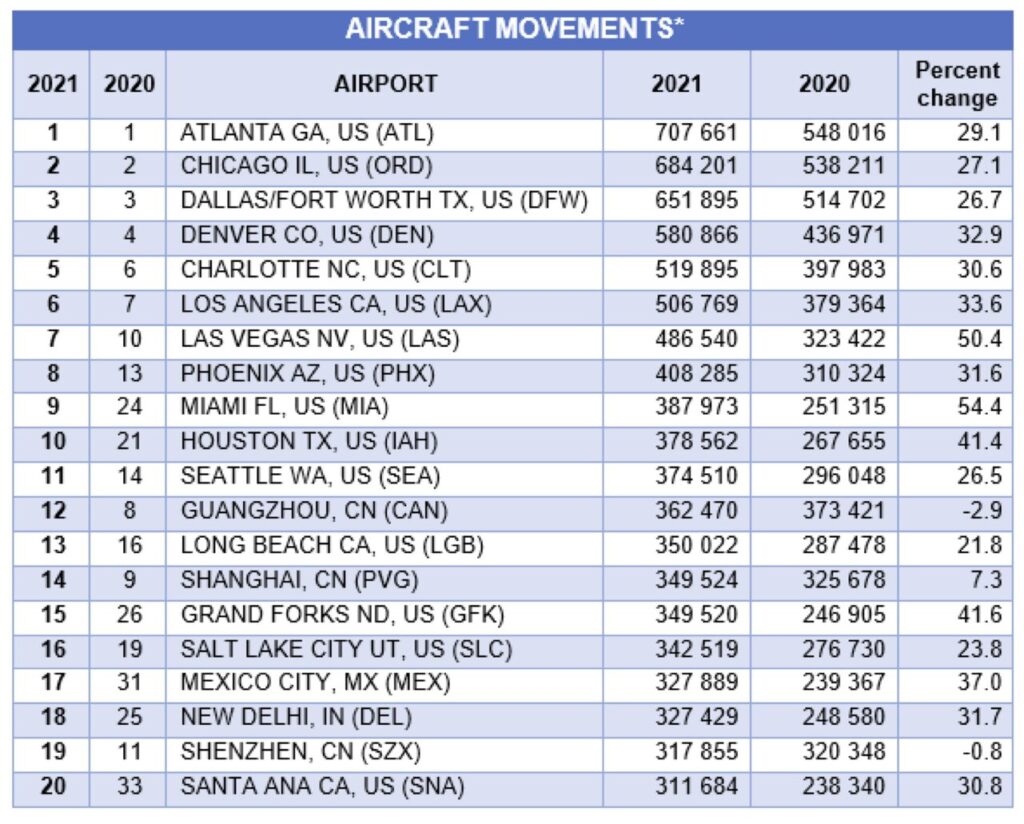Airports Council International (ACI) World has published its annual World Airport Traffic Dataset, revealing the extent of the aviation industry’s recovery and confirming global air traffic rankings for the full year 2021.
The World Airport Traffic Dataset features airport traffic for over 2,600 airports in more than 180 countries and territories. It provides a view of air transport demand across the world’s airports in three areas: passengers (international and domestic), air cargo (freight and mail) and aircraft movements (air transport movements and general aviation).
In 2021, the world’s airports accommodated 4.6 billion passengers, representing an increase of 28.3% from 2020 or a drop of 49.5% from 2019 results. The top 20 airports, representing 19% of global traffic (863 million passengers), experienced a gain of 42.9% from 2020 or a drop of 31.9% compared with their 2019 results (1.27 billion passengers in 2019).
Hartsfield-Jackson Atlanta International Airport in Georgia (ATL, 75.7 million passengers, +76.4%) is back on the top of the 2021 rankings, followed by Dallas/Fort Worth in Texas (DFW, 62.5 million passengers, +58.7%) and Denver (DEN, 58.8 million passengers, +74.4%). From the top 20 rankings, almost all airports have significant domestic traffic representing 65% to 100% of their total passengers. The only exception is Istanbul International Airport in Turkey (IST), with a larger international traffic share (72% of passenger traffic). * Total passengers enplaned and deplaned, passengers in transit counted once
* Total passengers enplaned and deplaned, passengers in transit counted once
Air cargo volumes increased by 15.4% year-on-year (+4.5% versus 2019), to a record 125 million metric tons in 2021. Air cargo volumes in the top 20 airports, representing around 44% (54.8 million metric tons) of the global volumes in 2021, gained 14.7% in 2021 year-on-year or 13.4% versus 2019. The gain can be attributed to improved economic conditions that drove an increase in demand for consumer goods and pharmaceutical products (such as personal protective equipment and vaccines).
Hong Kong International Airport in Hong Kong (HKG, 5.0 million metric tons, +12.5%) regained top rank from Memphis International Airport in Tennessee (MEM, 4.5 million metric tons, -2.9%), which inched back to the second position, followed by Shanghai International Airport in China (PVG, 4 million metric tons, +8.0%) in third. Compared with levels before the Covid-19 pandemic, the biggest jump in the top 20 rankings was recorded for Chicago’s O’Hare International Airport in Illinois (ORD), which improved its position by seven places, from 18th in 2019 to 11th in 2021. *Cargo: loaded and unloaded freight and mail in metric tonnes
*Cargo: loaded and unloaded freight and mail in metric tonnes
** includes transit freight
In 2021, global aircraft movements were close to 74 million, representing a gain of 18.7% from 2020 results or -28.2% versus 2019. The top 20 airports, representing 12% of global traffic (8.7 million movements), witnessed a gain of 27.9% from their 2020 results or a drop of 15.7% compared with their 2019 results (10.3 million in 2019).
Hartsfield-Jackson Atlanta International Airport (ATL) in Georgia is at the top, with 708,000 movements (+29.1% from 2020) but still below its 2019 result of 904,000 movements (-21.7%). ORD is still in second place after leading ATL in 2019 and 2018. *Movements: landings and takeoffs
*Movements: landings and takeoffs
Luis Felipe de Oliveira, director general of ACI World, said “Following the release of preliminary data earlier in the year, we are pleased to share ACI’s complete annual World Airport Traffic Dataset. The year 2021 represents the beginning of the aviation industry’s recovery. While some of the perennial busiest airport leaders have rejoined the upper ranks, other regions struggle to recover, leading to new entrants in the top 20. With many countries taking steps toward the return of some normality, lifting almost all the health measures and travel restrictions as supported by science, we welcome the continuation of air travel demand’s recovery in 2022, despite certain headwinds.”


